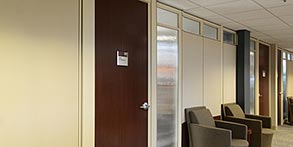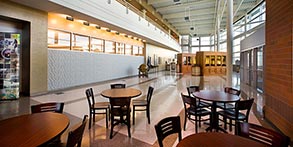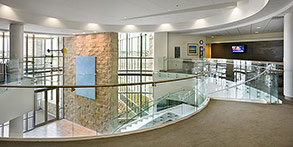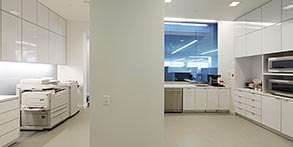- Create open-plan interior environments to accommodate changes.
- Limit interior partitions, private offices and rooms; use furniture or modular systems to provide privacy and acoustic control.
- When partitions are functionally justified such as for conference rooms, use systems furniture and moveable (demountable) floor-to-ceiling wall systems for acoustical or visual privacy.
- Proportion lobbies and common spaces based on type of function, activity and facility group.
- Allow no direct sight lines into restrooms.
- Situate utility and core areas to minimize impact on daylighting and to maximize use as thermal buffers.
- Ensure electrical, lighting and communications system can be adaptable to configuration changes.
- Avoid power poles to the maximum extent; when poles are necessary minimize the number and coordinate locations with furniture placement and other elements.
- Avoid sloping floors to maintain flexibility and eliminate future structural changes.
- Special consideration may apply to Sensitive Compartmented Information Facilities (SCIFs).
Provide open-plan configurations for office, administrative, operational and related activities and spaces for maximum flexibility. Use a “core and shell” approach in which all building systems, infrastructure and permanent interior partitions anticipate two or more uses (operations) during a facility’s lifespan. Create flexible interior configurations using Furniture, Fixtures & Equipment (FF&E) and limit private offices and private rooms. Refer to DAFMAN 32-1084 for space requirements. To the greatest extent, limit permanent partitions to core areas such as toilet rooms, stairs, mechanical and utility rooms. Use more durable long-lasting finishes in core areas for walls, ceilings, floor coverings and built-in casework. Coordinate interior FF&E layouts with structural grids.
Sustainability
Provide high-performance building configurations following UFC 1-200-02. Ensure passive design strategies are cost effectively incorporated before active mechanical systems are designed.
Fully integrate interior design to preserve and support passive systems and energy efficiencies. All passive systems such as thermal-mass walls, clerestories and daylighting systems, natural ventilation and convection cooling features, etc., must be sustained in interior design and renovations.
Resilience
Review and consider the potential impacts of documented risks when configuring interior spaces. Maintain and preserve integrated passive systems such as vestibules and thermal mass, which provide energy efficiency and comfort for occupants.
In areas at risk for tornadoes coordinate egress routes from interior spaces to storm shelters during the concept design phase of the facility design process and preserve these routes during the structural interior design and FF&E design process.
UFC 1-200-01 General Building Requirements https://www.wbdg.org/dod/ufc/ufc-1-200-01
UFC 1-200-02 High Performance and Sustainable Building Requirements https://www.wbdg.org/dod/ufc/ufc-1-200-02
UFC 3-120-10 Interior Design https://www.wbdg.org/dod/ufc/ufc-3-120-10
UFC 3-410-01 Heating, Ventilating, and Air Conditioning Systems https://www.wbdg.org/dod/ufc/ufc-3-410-01
UFC 3-450-01 Noise and Vibration Control https://www.wbdg.org/dod/ufc/ufc-3-450-01
UFC 4-010-05 Sensitive Compartmented Information Facilities Planning, Design, and Construction https://www.wbdg.org/dod/ufc/ufc-4-010-05
AFI 32-6002 U.S. Air Force Family Housing Planning, Programming, Design, and Construction https://static.e-publishing.af.mil/production/1/af_a4/publication/afi32-6002/afi32-6002.pdf
USAF/DOE Design Guide for Military Family Housing - Energy Efficient Revitalization and New Construction https://www.wbdg.org/FFC/AF/AFDG/milfam.pdf
US Air Force Family Housing Design Guide for Planning, Programming, Design and Construction https://www.wbdg.org/FFC/AF/AFDG/familyhousing.pdf
Department of the Air Force Manual (DAFMAN) 32-1084 Facility Requirements https://www.wbdg.org/FFC/AF/AFMAN/afman32-1084.pdf








